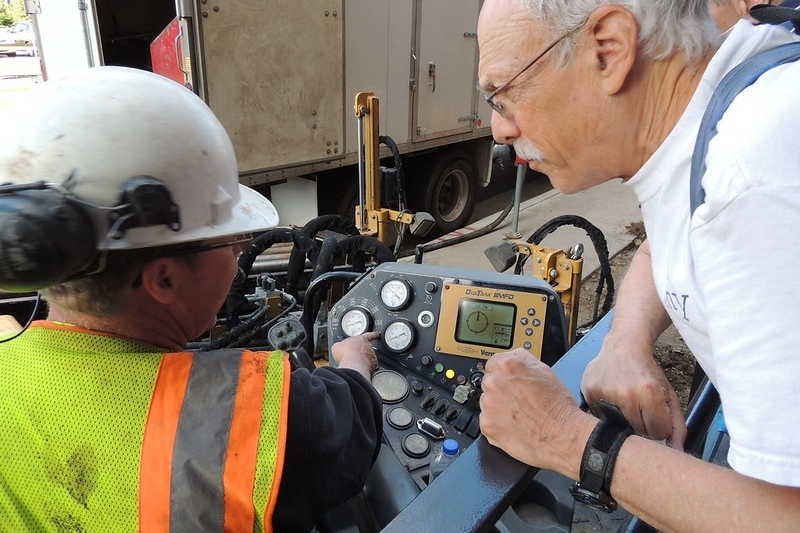Funding Lead Service Line Replacement Programs
The task of replacing lead service lines is set to receive a major financial boost from the federal government. But huge costs remain, and, until funding aligns with need, Illinois municipalities will have to find ways to cover those costs. Our partner at CDM Smith joins us to discuss some options.

In 2021, Illinois became one of only three states requiring the replacement of lead service lines, an important first step in getting rid of this toxic infrastructure. Unfortunately, that bill didn’t come with a funding source, leaving utilities to figure out for themselves how to finance this necessary public health measure.
There’s good news and bad news. The good news: The federal 2021 Bipartisan Infrastructure Law dedicated $15 billion nationally to funding lead service line replacement, and, of that, Illinois is anticipated to receive $550 million-plus over the next five years. That seems like—and indeed is—a lot of money. The bad news: It’s only 10.6 percent of the $5.3 billion needed, at minimum, to replace all lead service lines in Illinois. Also, Illinois is expected to receive fewer of these funds than we should based on our share of lead service lines. (Illinois has more than any other state.) The result? Utilities will need to find ways to fill the gap.
Unless municipalities can secure unconstrained sources of revenue, lead service line replacement programs are too often funded by ratepayer fees, which can burden low-income residents and lead to shutoffs of an essential good. How can utilities fund lead service line replacement programs without burdening residents who are least able to afford it? Some of the more creative ideas for offsetting the costs include a Lambeau Field sales tax rebate used to provide homeowner reimbursements in Wisconsin; and, in Cincinnati, a “Thirsty Thursday” program where local breweries donate a portion of their proceeds to fund replacement projects.
For communities without a Lambeau Field or residents who are very thirsty on Thursdays, what other options exist to fund replacement of lead service lines for all residents? We invited Amrou Atassi, Vice President and Senior Project Manager with CDM Smith, to weigh in.
Q&A with Amrou Atassi, PE, PMP, BCEE, from CDM Smith:
First, why should Illinois communities be proactive about developing a plan and identifying funding sources that pay for both the public and private side of the lead service line?
By planning ahead for funding, utilities can drive costs down and ensure their programs are effective. The Lead Service Line Replacement and Notification Act requires water systems to remove every lead service line (LSL) within a target date based on the number of LSLs a system currently has in their approved inventory. Water systems can use a prioritization strategy to systematically replace blocks of LSLs to reach their annual goal based on their funding strategy. This means that during infrastructure projects—such as water main replacements or repairs following a leak or a break on a water service line—the water system must provide a complete lead service line replacement (LSLR) unless a waiver is obtained from the resident. (Under the Act, no partial LSLR is allowed; the entire service line must be replaced from the water main to the first shut-off valve or 18 inches within the building’s plumbing, whichever is shorter.) For project efficiencies, and to prevent the need to redo work, water systems should also replace LSLs prior to street repaving and other similar projects.
Having a funding plan in place to cover the full cost of the LSLR programs means the cost of replacement is not left up to the resident, unfairly impacting low-income residents that may elect to opt out via a waiver, which will significantly hinder the water system’s ability to comply with the Act.
Aside from water rate increases, what other funding options are available for communities with LSLs?
Several funding options are available for LSLR:
- The Drinking Water State Revolving Fund (SRF) Loan Program will be getting more money from the recently passed Infrastructure Investment and Jobs Act. Specifically, $15 billion for LSLR funding will be routed to the SRF Loan Programs, so communities should be working on their SRF Project Plans to get in line for this funding. Forty-nine percent of this funding will be available as principal forgiveness funds for disadvantaged communities, but states are still evaluating the eligibility criteria.
- U.S. Dept. of Housing and Urban Development’s Community Development Block Grant program can provide LSLR funding assistance to individual residents that meet the income criteria.
- U.S. Environmental Protection Agency’s Water Infrastructure Improvements for the Nation grants can target LSLR funding. Over the last few years, several communities have applied and received targeted fundings for LSLR.
- Tax Increment Financing (TIF) District funds can be used for LSLR in TIF zones or districts with available funding for infrastructure projects.
- Some state grant programs, such as Rebuild Illinois, can be used for LSLR. Some communities in Illinois are currently allocating those grants for LSLR.
- Property tax assessments may be used at zero or low interest to finance the cost of the LSLR. This offers communities a funding stream to repay SRF loans or bonds.
Wow, that’s a lot of grant programs! In addition to grants, what creative financing mechanisms are utilities using to pay for lead service line replacement without burdening low-income residents? What about for predominantly low-income municipalities?
Communities often have other funding sources that can provide financial support for the community and associated capital projects. Those may include sales tax proceeds from sports, recreation, shopping centers, etc. These funding sources can be a component of the overall funding strategy but might not cover the entire cost of the program.
Whatever the funding strategy, the first step is to establish the various LSLR programs within a community and prioritize where, how, and when to replace LSLs. Once a program is established, then identified funding sources can be aligned with the program.
We have seen a variety of creative ideas to fund LSLR. Cincinnati, as you mentioned, had a “Thirsty Thursday” program, which used proceeds from local bars to help fund LSLR for low-income residents. Saint Louis County in Missouri adopted a program fee of $1.00 per month to fund LSLR when a service line needs to be repaired or replaced. This fee is collected on all residential water bills.
Predominantly low-income municipalities may have fewer creative options, so these communities should be prioritized for principal forgiveness under the SRF Loan Program.
In 2021, Congress passed the American Rescue Plan Act (ARPA), a coronavirus relief measure providing billions of dollars in funding for the State of Illinois and our local units of government. How can municipalities use ARPA money to make progress on LSLR programs, and how should they think about this money relative to other federal infrastructure dollars?
ARPA funds can be used for LSLR, and several communities have tapped ARPA funds to start or accelerate their LSLR efforts. While ARPA funds may not fully fund LSLR programs, they are an excellent way to start a LSLR program where neither the community nor the homeowner has to pay for the cost of replacement.
Whatever the funding strategy, the first step is to establish the various LSLR programs within a community and prioritize where, how, and when to replace LSLs. Once a program is established, then identified funding sources such as ARPA can be aligned with the program. For example, for a municipal capital improvement plan (e.g., replacing water and sewer main, street resurfacing, etc.) where the LSL is going to be impacted by the construction, the public side of the LSLR can be funded by the capital improvement project, and the private side can be funded by ARPA, SRF principal forgiveness, TIF funds, or other financing options.
Finally, what are the benefits for communities working together to tackle LSLR? What are the cost savings and other benefits in pooling resources?
Regardless of what funding strategies are employed, community collaboration can provide numerous advantages and opportunities. Working together on the LSLR inventory and sharing lessons learned in developing these inventories can assist everyone in overcoming technical hurdles. Beyond this, collaboration on technical specifications, bidding, and construction can be a cost saver. Communities can also work together to help the Illinois SRF program develop a uniform and consistent approach to prioritization and how to define the criteria for principal forgiveness.
Conclusion
As you can see, communities have a wide variety of options to fund lead service line replacement without putting an undue burden on their residents. With smart planning, collaboration, assistance from federal and state funding streams, and a little ingenuity, Illinois communities can find the funding to complete this important work.
Amrou Atassi, PE, PMP, BCEE, Vice President and Senior Project Manager at CDM Smith, specializes in drinking water treatment and distribution, water quality studies, corrosion control optimization, and lead service line replacement. Over his 22-year career, Amrou has worked with water systems across the Midwest on water quality, lead, corrosion control optimization, and other water quality challenges.
